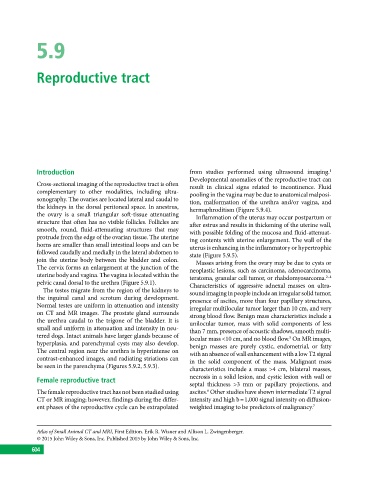Page 614 - Atlas of Small Animal CT and MRI
P. 614
5.9
Reproductive tract
Introduction from studies performed using ultrasound imaging.
1
Developmental anomalies of the reproductive tract can
Cross‐sectional imaging of the reproductive tract is often result in clinical signs related to incontinence. Fluid
complementary to other modalities, including ultra- pooling in the vagina may be due to anatomical malposi-
sonography. The ovaries are located lateral and caudal to tion, malformation of the urethra and/or vagina, and
the kidneys in the dorsal peritoneal space. In anestrus, hermaphroditism (Figure 5.9.4).
the ovary is a small triangular soft‐tissue attenuating Inflammation of the uterus may occur postpartum or
structure that often has no visible follicles. Follicles are after estrus and results in thickening of the uterine wall,
smooth, round, fluid‐attenuating structures that may with possible folding of the mucosa and fluid‐attenuat-
protrude from the edge of the ovarian tissue. The uterine ing contents with uterine enlargement. The wall of the
horns are smaller than small intestinal loops and can be uterus is enhancing in the inflammatory or hypertrophic
followed caudally and medially in the lateral abdomen to state (Figure 5.9.5).
join the uterine body between the bladder and colon. Masses arising from the ovary may be due to cysts or
The cervix forms an enlargement at the junction of the neoplastic lesions, such as carcinoma, adenocarcinoma,
uterine body and vagina. The vagina is located within the teratoma, granular cell tumor, or rhabdomyosarcoma.
2–4
pelvic canal dorsal to the urethra (Figure 5.9.1). Characteristics of aggressive adnexal masses on ultra-
The testes migrate from the region of the kidneys to sound imaging in people include an irregular solid tumor,
the inguinal canal and scrotum during development. presence of ascites, more than four papillary structures,
Normal testes are uniform in attenuation and intensity irregular multilocular tumor larger than 10 cm, and very
on CT and MR images. The prostate gland surrounds strong blood flow. Benign mass characteristics include a
the urethra caudal to the trigone of the bladder. It is unilocular tumor, mass with solid components of less
small and uniform in attenuation and intensity in neu- than 7 mm, presence of acoustic shadows, smooth multi-
tered dogs. Intact animals have larger glands because of locular mass <10 cm, and no blood flow. On MR images,
5
hyperplasia, and parenchymal cysts may also develop. benign masses are purely cystic, endometrial, or fatty
The central region near the urethra is hyperintense on with an absence of wall enhancement with a low T2 signal
contrast‐enhanced images, and radiating striations can in the solid component of the mass. Malignant mass
be seen in the parenchyma (Figures 5.9.2, 5.9.3). characteristics include a mass >4 cm, bilateral masses,
necrosis in a solid lesion, and cystic lesion with wall or
Female reproductive tract
septal thickness >3 mm or papillary projections, and
The female reproductive tract has not been studied using ascites. Other studies have shown intermediate T2 signal
6
CT or MR imaging; however, findings during the differ- intensity and high b = 1,000 signal intensity on diffusion‐
ent phases of the reproductive cycle can be extrapolated weighted imaging to be predictors of malignancy. 7
Atlas of Small Animal CT and MRI, First Edition. Erik R. Wisner and Allison L. Zwingenberger.
© 2015 John Wiley & Sons, Inc. Published 2015 by John Wiley & Sons, Inc.
604

